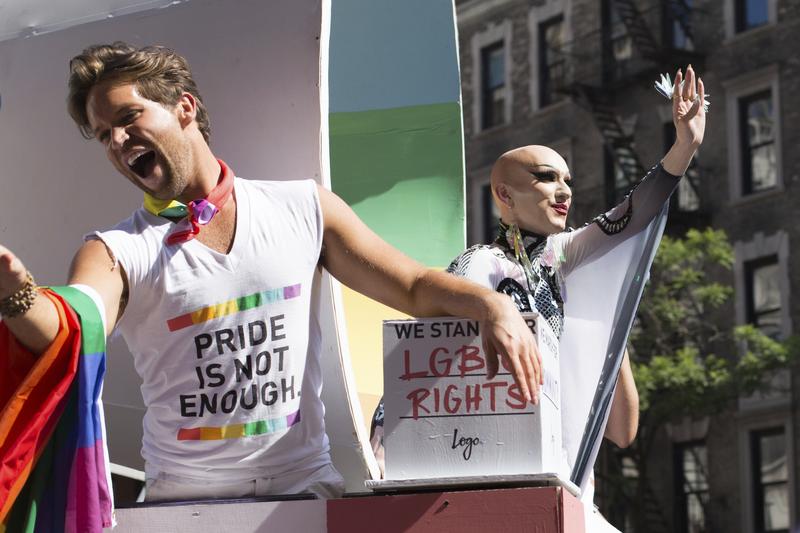Melissa Harris-Perry: I'm Melissa Harris-Perry, and you're listening to The Takeaway. If you're just joining us, we've been discussing how the recent census data will affect how district lines are drawn for state legislators, city councils, Congress, and more. As redistricting gets underway, some marginalized groups are seeing it as an opportunity to increase political power.
The Victory Fund, a national organization dedicated to electing LGBTQ people, is pushing to keep LGBTQ neighborhoods united as maps are redrawn. Thereby strengthening collective voting power. For more on this, we're joined by Sean Meloy, Vice President of Political Programs at the LGBT Victory Fund. Sean, great to have you here.
Sean Meloy: Hello, thank you for having me.
Melissa Harris-Perry: What is the, We Belong Together campaign and how did it get started?
Sean Meloy: This is an opportunity for the LGBTQ community to ensure that our voices are heard as maps are redrawn following the census data that was just collected. We were inspired by some great successes in California, where Equality California helped make sure LGBTQ communities had their little district lines, respect the actual voices of the people who live there, and that's led to great success. We're very excited to keep that going with our We Belong Together toolkit.
Melissa Harris-Perry: Help me understand this particular definition of LGBTQ communities. Because when I think about LGBTQ communities, I think of identity communities, not necessarily geographic ones. In ways that like the historic realities of racial discrimination created housing patterns, where you can plop down and see ethnic neighborhoods. You can see racialized neighborhoods. Is that also true for queer neighborhoods?
Sean Meloy: Yes, that's what we found when they did this work in California, and what so many people feel in the neighborhoods in which they live in many cities across the United States. We feel that those voices should be respected, and are certainly considered through this process.
Melissa Harris-Perry: Now clearly, LGBTQ folk are not all in one political party. In fact, perhaps the diversity is even greater among this particular identity community of interest. Then for example, among African-Americans who do tend to vote in much larger blocks towards, for example, the Democratic Party. How does it work to think about drawing district lines, respecting identity and communities of interest, while also acknowledging that there might be some real partisan differences?
Sean Meloy: One of the things that we're working to do here is to make sure that people understand that there is a lack of data when it comes to LGBTQ people, and that has helped lead to us being underrepresented in a lot of aspects of government, including map-making. One of the things that we're working to do with this project is to say, "We need to collect more data, and we need to actually make sure LGBTQ people are accounted for."
We can actually make those distinct as we're able to do with other minority communities that are collected by the census. LGBTQ people do vote at an 80% plus clutch for Democrats, and feel that they are helping make sure that LGBTQ equality becomes accomplished. We are very similar in that regard, and we think that these neighborhoods and their voting patterns actually will help showcase that.
Melissa Harris-Perry: Now, talk to me about the balance between the identities of the representatives that you seek to elect. If we think about, for example, Congressional Black Caucus districts, or those CBC districts. It's always sort of a two-part goal, both a goal of electing more Black representatives and particular policy issues that are on the agenda. Talk to me a little bit about electing more LGBTQ politicians representatives and about what some of the policy issues are?
Sean Meloy: Well, LGBTQ Victory Fund is all about getting LGBT people elected, and those elected officials acting not only for their communities but to help make sure that LGBTQ equality is achieved. We think that when these people are elected from these districts, we know that they're actually doing that. We also know that these districts are diverse. We know that LGBTQ people come in all shapes and sizes across every demographic.
We are able to actually draw districts in California. Last cycle, there was an LGBTQ Latino propensity district, and we think that there's potential for other communities like that around the country, that would actually align with some of the other goals that come from making sure other minority communities are represented.
Melissa Harris-Perry: Sean Malloy is the Vice President of Political Programs at the Victory Fund. Thank you so much for joining us.
Sean Meloy: Thank you.
[00:04:53] [END OF AUDIO]
Copyright © 2021 New York Public Radio. All rights reserved. Visit our website terms of use at www.wnyc.org for further information.
New York Public Radio transcripts are created on a rush deadline, often by contractors. This text may not be in its final form and may be updated or revised in the future. Accuracy and availability may vary. The authoritative record of New York Public Radio’s programming is the audio record.




